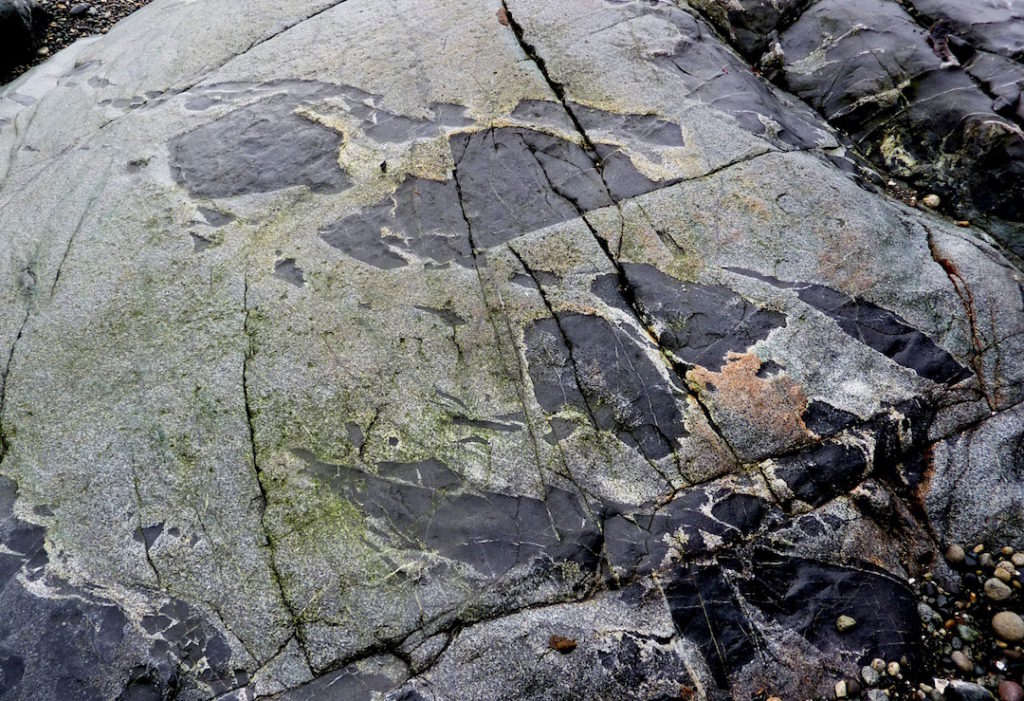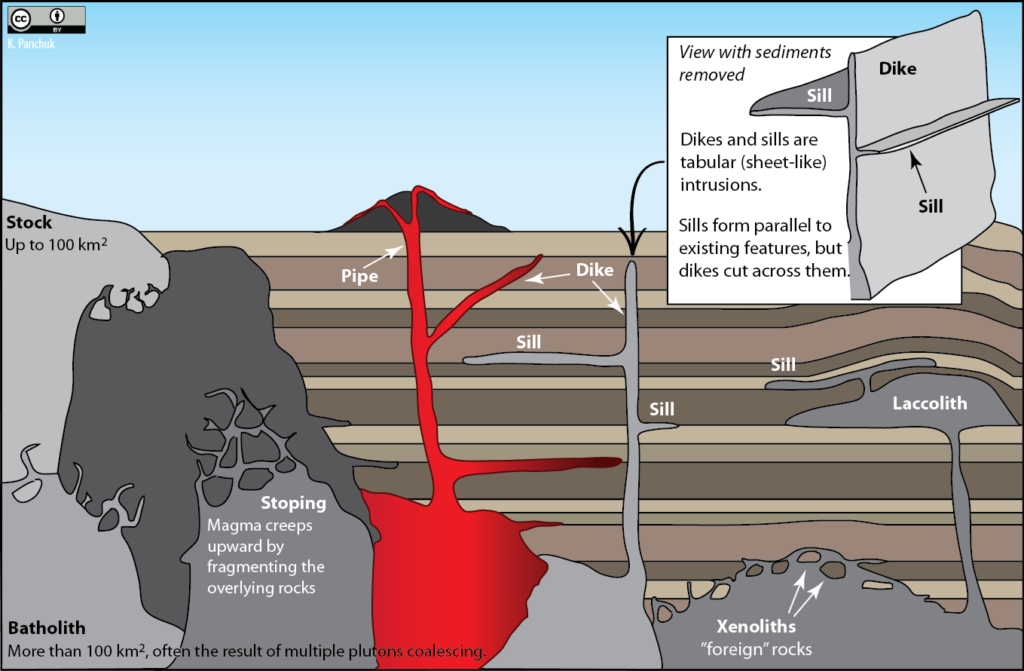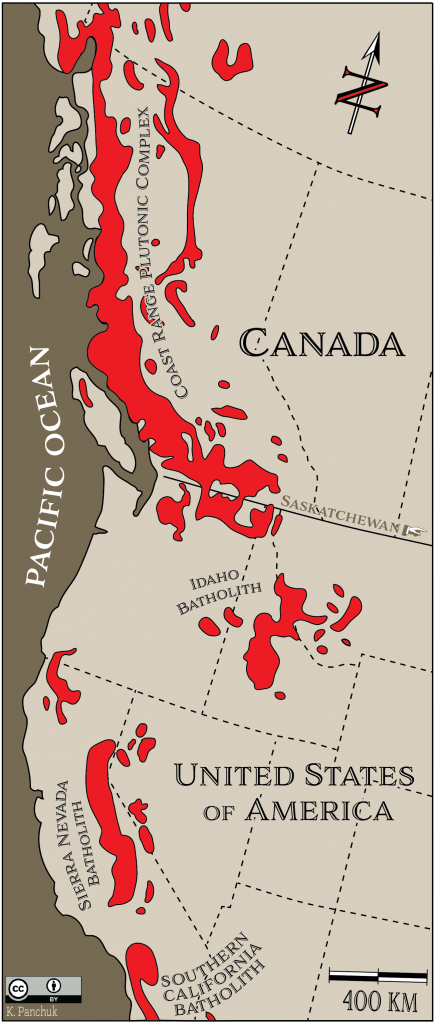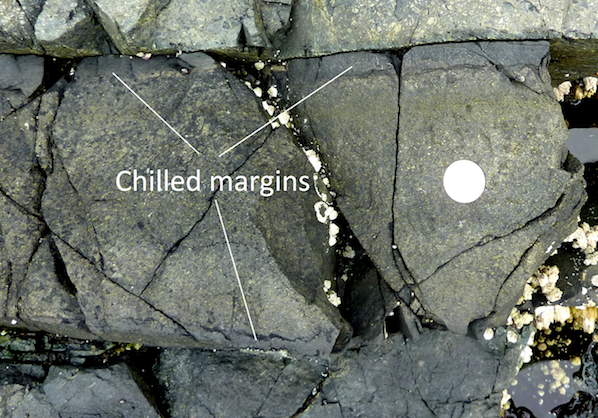7.4 Intrusive Igneous Rocks
In most cases, a body of hot magma is less dense than the rock surrounding it, so it has a tendency to creep upward toward the surface. It does so in a few different ways:
- Filling and widening existing cracks
- Melting the surrounding rock
- Pushing the rock aside (where the rock is hot enough and under enough pressure to deform without breaking)
- Breaking the rock
When magma forces itself into cracks, breaks off pieces of rock, and then envelops them, this is called stoping. The resulting fragments are xenoliths[1]. Xenoliths may appear as dark patches within a rock (Figure 7.21).

Some of the magma may reach the surface, resulting in volcanic eruptions, but most cools within the crust. The resulting body of rock is called a pluton.[2] Plutons can have different shapes and different relationships with the surrounding country rock (Figure 7.22). These characteristics determine what name the pluton is given.
Large, irregularly shaped plutons are called stocks or batholiths, depending upon their size. Tabular plutons are called dikes if they cut across existing structures, and sills if they are parallel to existing structures. Laccoliths are like sills, except they have caused the overlying rocks to bulge upward. Pipes are cylindrical conduits.

Types of Plutons
Stocks and Batholiths
Large irregular-shaped plutons are called either stocks or batholiths, depending on their area. If an irregularly shaped body has an area greater than 100 km2, then it’s a batholith, otherwise it’s a stock. Note that our knowledge of the size of a body can be limited to what we see at the surface. A body with an area of less than 100 km2 exposed at the surface might in fact be much larger at depth. It might be classified as a stock initially, until someone is able to map out its true extent.
Batholiths are typically formed when a number of stocks coalesce beneath the surface to create one large body. One of the largest batholiths in the world is the Coast Range Plutonic Complex[3], which extends all the way from the Vancouver region to southeastern Alaska (Figure 7.23).

Tabular Intrusions
Tabular (sheet-like) plutons are classified according to whether or not they are concordant with (parallel to) existing layering (e.g., sedimentary bedding or metamorphic foliation[4]) in the country rock. A sill is concordant with existing layering, and a dike[5] is discordant. If the country rock has no bedding or foliation, then any tabular body within it is a dike. Note that the sill-versus-dike designation is not determined simply by the orientation of the feature. A dike could be horizontal and a sill could be vertical- it all depends on the orientation of features in the surrounding rocks.
A laccolith is a sill-like body that has expanded upward by deforming the overlying rock. If a sill forms, but magma pools and sags downward, it creates a lopolith.
Pipes
A pipe, as the name suggests, is a cylindrical body with a circular, elliptical, or even irregular cross-section, that serves as a conduit (or pipeline) for the movement of magma from one location to another. Pipes may feed volcanoes, but pipes can also connect plutons.
Chilled Margins
As discussed already, plutons can interact with the rocks into which they are intruded. Partial melting of the country rock may occur, or stoping may form xenoliths. The heat from magma can even cause causing mineralogical and textural changes in country rock. However, country rock can also affect the magma.
The most obvious effect that country rock can have on magma is a chilled margin along the edges of the pluton (Figure 7.24). The country rock is much cooler than the magma, so magma that comes into contact with the country rock cools faster than magma toward the interior of the pluton. Rapid cooling leads to smaller crystals, so the texture along the edges of the pluton is different from that of the interior of the pluton, and the colour may be darker.

Exercise: Pluton Problems
The diagram below is a cross-section through part of the crust showing a variety of intrusive igneous rocks. Indicate whether each of the plutons labelled a to e on the diagram below is a dike, a sill, a stock, or a batholith. (Note the trees for scale.)

References
Bally, A. W. (1989). Plate 10. Selected distribution maps, rate of accumulation maps, and lithofacies maps—Phanerozoic, North America. In A. W. Bally & A. R. Palmer (Eds.), The Geology of North America—An Overview: Volume A. Boulder: Geological Society of America.
- From the Greek words xenos, meaning "foreigner" or "stranger," and lithos for "stone." ↵
- After Pluto was demoted from planet status, astronomers tried to come up with a name for objects like Pluto. For a while they considered "pluton" however geologists rightly objected that they had first claim on the word. In the end the International Astronomical Union settled on "dwarf planet" instead. ↵
- Also referred to as the Coast Range Batholith ↵
- Sedimentary bedding refers to the layers in which sedimentary rocks form. Metamorphic foliation refers to the way minerals or other elements in a rock are aligned as a result of being deformed by heat and pressure. Bedding and foliation will be discussed in more detail in later chapters. ↵
- Also spelled dyke. ↵

